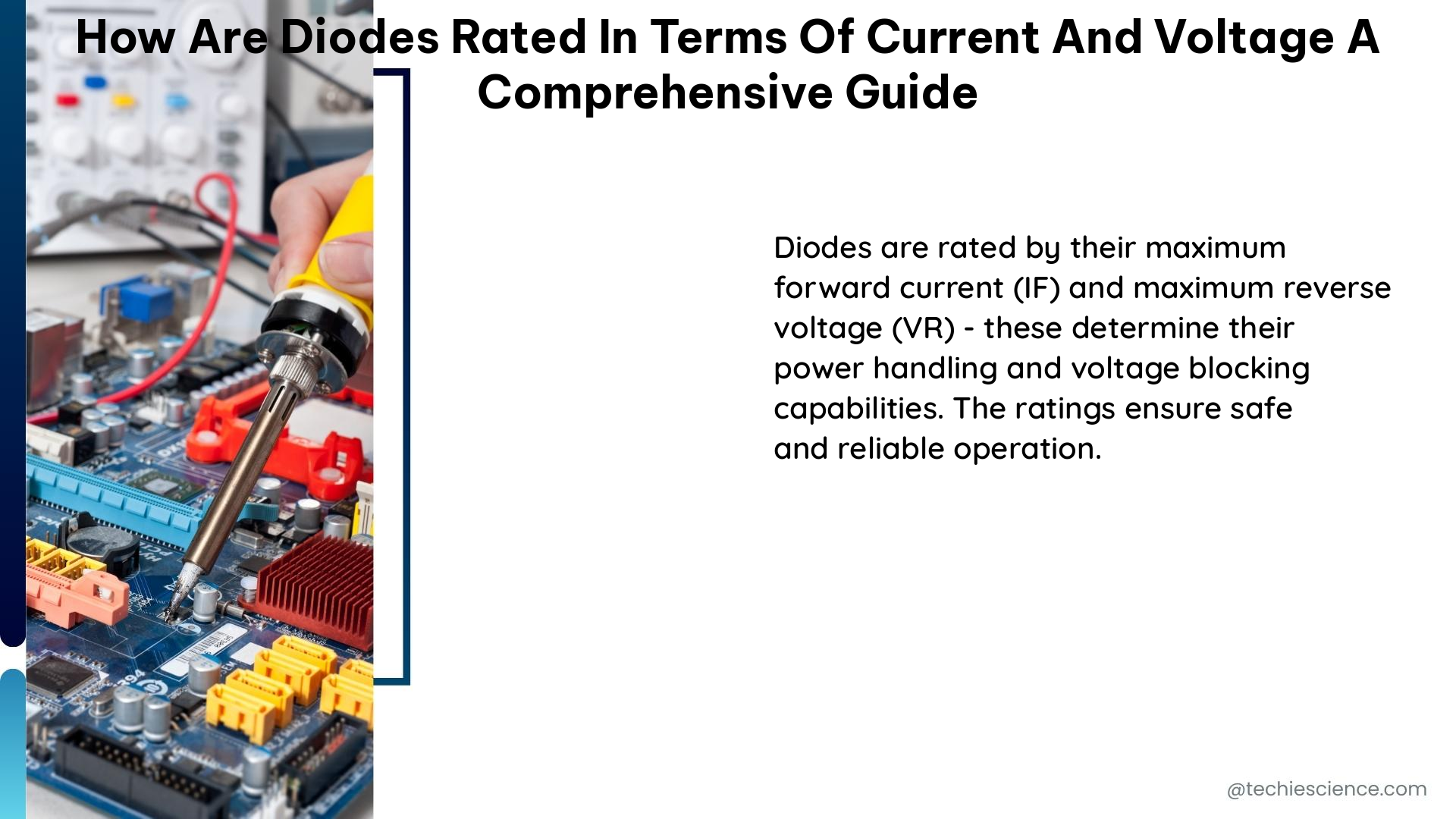Diodes, a fundamental component in electronics, are rated in terms of current and voltage to ensure their safe and efficient operation in a circuit. The ratings are specified by the manufacturer in the diode’s datasheet and are crucial for circuit designers to consider during the design and implementation stages. This comprehensive guide will delve into the technical specifications of diode ratings, focusing on current and voltage ratings, and provide examples and numerical problems for better understanding.
Voltage Ratings
Voltage ratings for diodes are crucial in determining their ability to withstand voltage in both forward and reverse bias modes. The key voltage ratings are:
-
Maximum Forward Voltage (Vf): This is the maximum voltage a diode can withstand in the forward-biased state. It is usually specified at the diode’s rated forward current. Ideally, this figure would be zero, indicating no opposition to forward current. Typical values for Vf range from 0.3V to 1.7V, depending on the diode type and semiconductor material. For example, a silicon diode may have a Vf of around 0.7V, while a Schottky diode can have a Vf as low as 0.2V.
-
Maximum Reverse Voltage (VRRM): This is the maximum amount of voltage a diode can withstand in reverse-bias mode, in repeated pulses. Ideally, this figure would be infinite. Typical values for VRRM range from 50V to 1000V, depending on the diode’s application and voltage requirements. High-voltage diodes used in power supplies or X-ray equipment may have VRRM ratings of several kilovolts.
-
Maximum DC Reverse Voltage (VR or VDC): This is the maximum amount of voltage a diode can withstand in reverse-bias mode on a continual basis. Again, ideally, this figure would be infinite. Typical values for VR range from 20V to 600V, depending on the diode’s application and voltage requirements.
-
Peak Inverse Voltage (PIV): This is the maximum reverse voltage a diode can withstand for a very short duration, typically in the order of microseconds. Typical values for PIV range from 50V to 1000V, similar to the VRRM rating.
Current Ratings

Current ratings for diodes are essential in determining their ability to conduct current in forward bias mode. The key current ratings are:
-
Maximum (average) Forward Current (IF(AV)): This is the maximum average amount of current a diode is able to conduct in forward bias mode. This rating is fundamentally a thermal limitation, indicating how much heat the PN junction can handle. Typical values for IF(AV) range from 100mA to 50A, depending on the diode’s size, package, and cooling methods.
-
Maximum (peak or surge) Forward Current (IFSM or if(surge)): This is the maximum peak amount of current a diode is able to conduct in forward bias mode. This rating is also limited by the diode junction’s thermal capacity. Typical values for IFSM range from 1A to 1000A, depending on the diode’s size and package.
-
Reverse Recovery Time (trr): This is the amount of time it takes for a diode to “turn off” when the voltage across it alternates from forward-bias to reverse-bias polarity. Typical values for trr range from 10ns to 1μs, depending on the diode’s design and semiconductor material.
Power Ratings
Power ratings for diodes are crucial in determining their ability to dissipate power without overheating. The key power rating is:
- Maximum Total Dissipation (PD): This is the amount of power (in watts) allowable for the diode to dissipate, given the dissipation of diode current multiplied by diode voltage drop, and also the dissipation of diode current squared multiplied by bulk resistance. Typical values for PD range from 0.25W to 50W, depending on the diode’s size, package, and cooling methods.
Temperature Ratings
Temperature ratings for diodes are essential in determining their ability to operate within a safe temperature range. The key temperature rating is:
- Junction Temperature (Tj): This is the maximum temperature a diode’s junction can reach. Exceeding this temperature can lead to permanent damage. Typical values for Tj range from 125°C to 175°C, depending on the diode’s design and packaging.
Numerical Problems
- A diode has a maximum forward voltage (Vf) of 1V and a maximum average forward current (IF(AV)) of 200mA. What is the maximum power dissipation (PD) of the diode, assuming a forward voltage drop of 0.7V?
Given:
Vf = 1V
IF(AV) = 200mA
Vf(forward voltage drop) = 0.7V
To find:
PD = ?
Solution:
PD = Vf * IF(AV)
PD = 0.7V * 200mA
PD = 140mW
- A solenoid has a nominal current consumption rate of 500mA. What should be the average current rating of the flyback diode, considering a multiplication factor of 10?
Given:
Solenoid nominal current = 500mA
To find:
Average current rating of the flyback diode = ?
Solution:
Average current rating of the flyback diode = Solenoid nominal current * 10
Average current rating of the flyback diode = 500mA * 10
Average current rating of the flyback diode = 5A
Reference Links
- Basics of Diodes (Absolute Maximum Ratings and Electrical Characteristics) Application Note
- Diode Ratings | Diodes and Rectifiers | Electronics Textbook
- Starter guide for diodes : r/AskElectronics – Reddit

The lambdageeks.com Core SME Team is a group of experienced subject matter experts from diverse scientific and technical fields including Physics, Chemistry, Technology,Electronics & Electrical Engineering, Automotive, Mechanical Engineering. Our team collaborates to create high-quality, well-researched articles on a wide range of science and technology topics for the lambdageeks.com website.
All Our Senior SME are having more than 7 Years of experience in the respective fields . They are either Working Industry Professionals or assocaited With different Universities. Refer Our Authors Page to get to know About our Core SMEs.